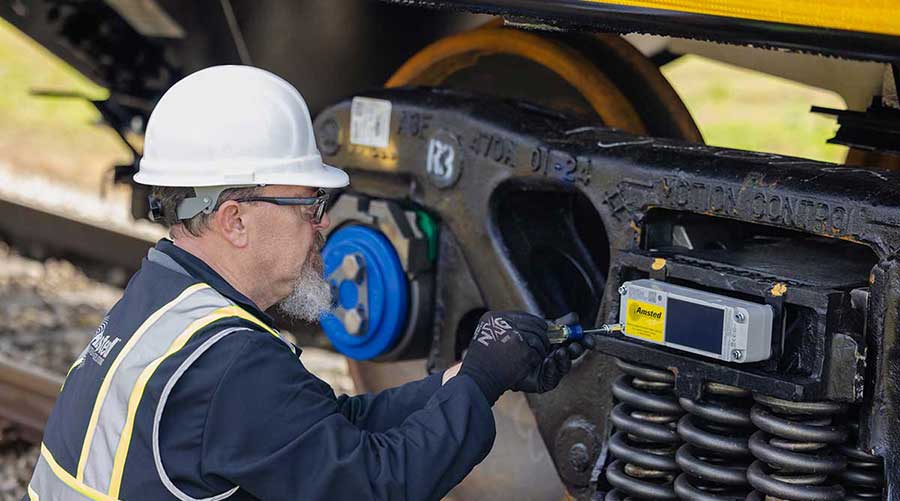Stay updated on news, articles and information for the rail industry
December 2010
Part 1 : Rail Outlook: 2011
Class I Outlook: 'Year of Opportunity'
Part 4 : 'Certainty is what drives investment' — AAR's Ed Hamberger
Part 5 : Short-Line Outlook 2011
Passenger Rail Outlook 2011 - 'Still a Little Tenuous'
High-Speed Rail: In flux in 2011
Part 8 : Rail-Car Deliveries in 2011
Part 9 :
Going with the in-flux flow (Outlook 2011) and Class I workforce data (Pat Foran, Context, December 2010)
Rail News: Rail Industry TrendsGoing with the in-flux flow (Outlook 2011) and Class I workforce data (Pat Foran, Context, December 2010)
— by Pat Foran, Editor
Railroaders and transportation industry observers continue to be reluctant to characterize with any degree of precision where the economic evolution's taking us. They're also a bit reticent to predict how the ever-changing political landscape might affect the rail world as they've known it. It's a casualty of this "new normal" we've been working our way through the past couple of years: There's too much uncertainty in too many contexts to be absolutely sure about lies ahead. But if the sentiments freight- and passenger-rail execs and other transport industry thought leaders shared with us during the reporting for our Outlook 2011 coverage are any indication, they're also beginning to accept the uncertainty: Change has pervaded their respective realms and they're going with the in-flux flow ... or at least making a go of going with it.
Along the way, and in spite of all the uncertainty, they've collectively concluded this: The economy will continue to improve, albeit slowly, and rail traffic and ridership will continue to rise accordingly.
A mild prediction, but a strong one. They're sure of this slow growth, although there's no one big-picture view or shared definition of "slow" — or "growth," for that matter.
Not that there won't be uncertainties to think about, plan around and otherwise contend with during the year ahead. Among them: doings in D.C. Will the stop-spending tenor change Congress' approach to (and potential embrace of) public investment in rail? If the recovery creep should come to a halt (or a perceived one), and/or unemployment levels remain staggeringly high, will congressfolk elected in part because of the no-spending promise be forced to reconsider their tea-leave readings?
There's also no consensus about where contract negotiations between rail carriers and three labor coalitions might end up. The national contract came open for amendment Jan. 1, 2010. Issues include wages, health care and benefits — all to be negotiated in the current economic and political contexts. Association of American Railroads President and CEO Ed Hamberger characterized the potential for resolution(s) as a "stochastic" or random variable.
"There's a sense that 2011 is the year of decision, as they say, with the contract," he said during a Nov. 19 interview. "Not knowing how that's going to turn out could be the biggest uncertainty."
The contract "may come down to a President Emergency Board (note: first word isn't 'Congressional') under the historic vagaries of the Railway Labor Act, perhaps in May 2011," wrote transportation analyst and Progressive Railroading columnist Tony Hatch in a Nov. 17 note to clients. For rail labor's part, there was no one-answer-fits-all assessment as of early December. All officials from the United Transportation Union (UTU) would allow was this: UTU — North America's largest rail union — and the carriers were "engaged in productive interest-based bargaining seeking innovative solutions that produce gains for carriers and UTU-represented employees," said UTU spokesman Frank Wilner in a Dec. 1 email, adding that a voluntary accord "is the preferred result."
Such certainty is always preferred. For now, though, railroaders of every shade and stripe will continue to work on their in-flux game. And we'll continue to track their progress.
Help Wanted — and Found
As U.S. Class Is ramp up for the aforementioned slow-growth stretch (as well as the retirements that'll come in a big way in the not-too-distant future), they're continuing to beef up their employment rosters. In October, the Class I workforce increased on both a month-over-month and year-over-year basis in just about every category, according to Surface Transportation Board (STB) data.
As of mid-October, the U.S. Class Is employed a total of 154,285 people, up 0.1 percent compared with September's level and 3.5 percent compared with October 2009's count. The only workforce segment that registered a month-over-month decline: transportation (other than train and engine) ranks, which dipped 0.5 percent from September's mark to 6,565. However, the segment rose 3.2 percent on a year-over-year basis.
Compared with mid-September levels, the number of executives/officials/staff assistants as of mid-October rose 0.4 percent to 9,120; professional and administrative staff increased 0.3 percent to 13,799; maintenance of equipment and stores staff expanded 0.3 percent to 28,294; maintenance-of-way and structures staff rose 0.2 percent to 35,056; and transportation (T&E) staff inched up 0.01 percent to 61,451.
On a year-over-year basis, most workforce segments increased from 0.2 percent to 1.4 percent, while transportation (T&E) ranks swelled 7.4 percent.


 2025 MOW Spending Report: Passenger-rail programs
2025 MOW Spending Report: Passenger-rail programs
 Gardner steps down as Amtrak CEO
Gardner steps down as Amtrak CEO
 Guest comment: Oliver Wyman’s David Hunt
Guest comment: Oliver Wyman’s David Hunt
 Women of Influence in Rail eBook
Women of Influence in Rail eBook
 railPrime
railPrime





